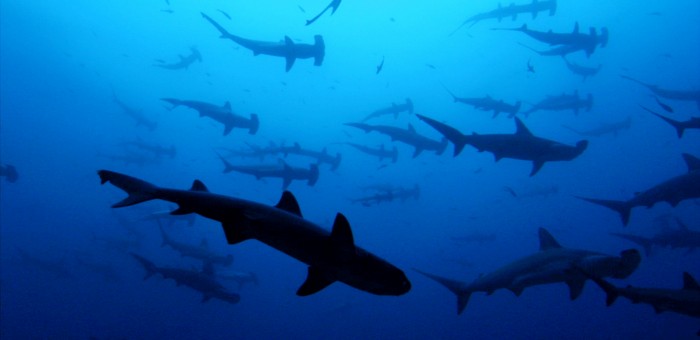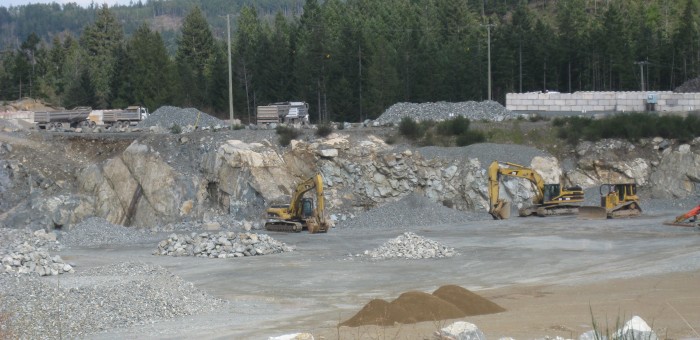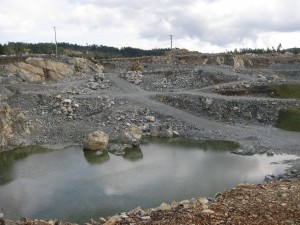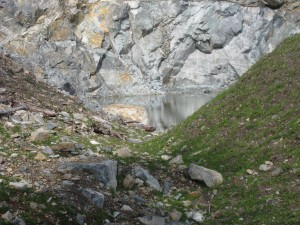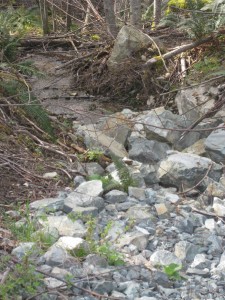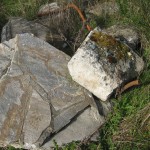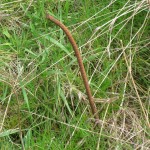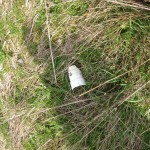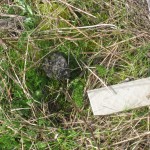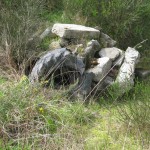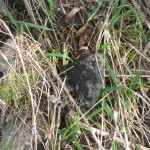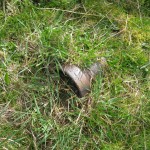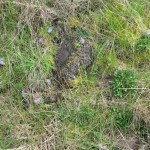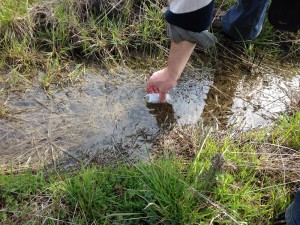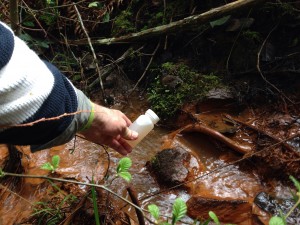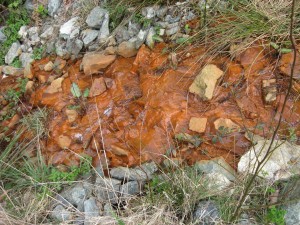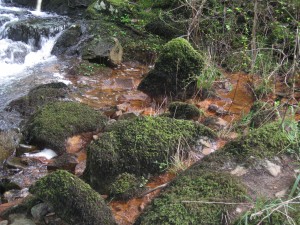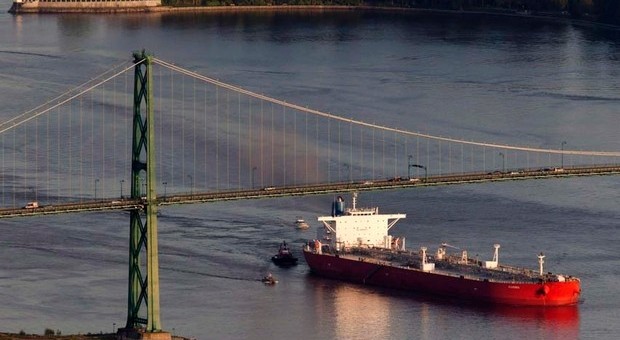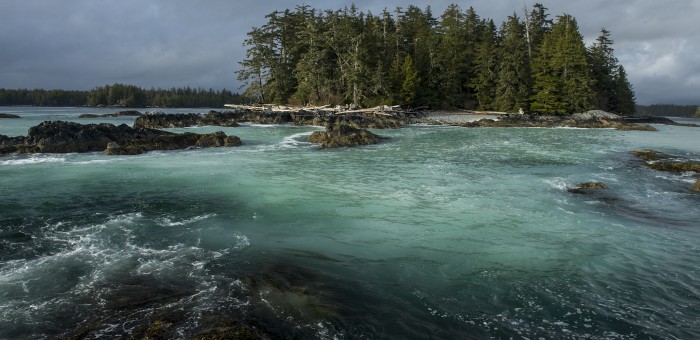Environment
Bill 21: Fish and Seafood Act
Summary of the Bill
Yesterday, Bill 21, 2015: Fish and Seafood Act passed third reading and now awaits Royal Assent. All members in the Legislature supported it. The Fish and Seafood Act replaces and updates the Fish Inspection Act and the Fisheries Act, last updated in the 1960s, with a modern framework that builds on British Columbia’s local and international reputation as a source of sustainable and trusted seafood products. It further improves operating conditions for British Columbia’s seafood sector.
The new legislation will update the licensing and regulation of the buying, selling, handling, storing and processing of fish, shellfish and aquatic plants. The legislation will also include the following to support sustainability and consumer confidence in the safety of B.C. seafood:
- Enabling the creation of a seafood traceability system to ensure seafood processed in British Columbia is both safe and legally caught, cultured, bought and sold. The system will ensure British Columbia seafood products are responsibly produced and harvested, and can be traced from the processor to the consumer.
- Prohibiting the possession of illegally caught, cultured, harvested or processed seafood products, and the unlicensed sale of fish, ensuring only sustainably harvested and safely handled seafood products enter the food chain.
The new act also increases inspection and enforcement.
Banning the Sale, Trade and Distribution of Shark Fins
On November 19, 2014 I was visited by a remarkable group of students from Glenlyon Norfolk School who, together with their teacher, had been working tirelessly to do what they can to make people aware of the plight of the world’s shark population. Following my meeting with the students I asked the Minister of Agriculture two questions during Question Period:
1) Will the government introduce legislation to ban the sale, trade and distribution of shark fins in British Columbia?
2) Will the government commit to working with me and other MLAs to develop a strategy that would eventually lead to banning the sale, trade and distribution of shark fins in British Columbia?
In response, the Minister subsequently committed to meet with me to discuss the issue. We met and at the meeting I promised to put together a package of information that he committed to pass along to Ministry staff for a thorough review.
Shortly after the meeting, I presented the Minister with a binder containing detailed and comprehensive information outlining the rationale for implementing shark fin legislation. The response to my information package that I received from the Minister in February was disappointing. The Minister did not respond to my specific question as to whether the government would consider introducing legislation to ban the sale, trade and distribution of shark fins in British Columbia.
The good news and new reality is that the government has since introduced Bill 21: Fish and Seafood Act. This Bill opens the door for moving forward on a ban on the sale, trade and distribution of shark fins in British Columbia. The key and relevant aspects of this bill are contained in section 6:
Possession or distribution of restricted fish or aquatic plants
6 (1) In this section, “restricted fish or aquatic plants” means prescribed fish or aquatic plants that
(a) are subject to prohibitions or restrictions on harvesting under an enactment of Canada or an international agreement to which Canada is a party, or
(b) may be subject to harvesting practices that are inhumane or unsustainable.
(2) A person must not possess or distribute for human consumption restricted fish or aquatic plants except as authorized under
(a) a licence, permit or other authorization issued under an enactment of Canada, or
(b) a permit issued by a licensing officer.
Yesterday at committee stage for the Bill I probed the minister on the implications of section 6 with respect to the sale, trade and distribution of shark fin products in British Columbia. I pick up the questioning immediately after Gary Holman, the MLA for Saanich North and the Islands asked the Minister if the list of restricted species would be published in the regulations attached to Bill 21.
Please note that this was the first time that I stood to speak on Monday. I had surgery on my nose last Friday and showed up in the legislature wearing a nose splint. The beginning of our conversation involves some back and forth banter about the dangers of texting while you walk.
Bill 21 Committee Stage Questions/Answers
G. Holman: There’s this reference to “restricted fish or aquatic plants,” and there are references to prohibitions or restricted “under an enactment of Canada or international agreement.” Will this list of restricted species be published in the regulations?
Hon. N. Letnick: Yes.
A. Weaver: Could the minister please expand on what basis this list will be determined?
Hon. N. Letnick: Thank you to — I believe — the member opposite for the question. I’m not too sure. We’re going to have to get an explanation of that in a minute, I’m sure.
The restricted fish and aquatic plants are those that are under two categories: (a) are subject to national or international prohibitions or restrictions on harvesting, and (b) may be subject to harvesting practices that are inhumane or unsustainable.
 A. Weaver: That was an opening for me. I recognize it’s very hard to take me seriously when I look like Beak Man here. There’s always a teachable moment in everything that we do in our lives, and the teachable moment that I have here is that one should not text and walk. We hear a lot about texting and driving and the dangers of texting and driving, but let me tell you, hon. Chair, also texting and walking can be very dangerous, particularly if you’re jogging downstairs quickly while texting and not looking where you’re going.
A. Weaver: That was an opening for me. I recognize it’s very hard to take me seriously when I look like Beak Man here. There’s always a teachable moment in everything that we do in our lives, and the teachable moment that I have here is that one should not text and walk. We hear a lot about texting and driving and the dangers of texting and driving, but let me tell you, hon. Chair, also texting and walking can be very dangerous, particularly if you’re jogging downstairs quickly while texting and not looking where you’re going.
With that, if I could continue on this. Does this mean that if an organization called the United Nations International Union for the Conservation of Nature, through their red list, were to deem a particular species to be protected and subject to international restrictions, this law would then apply in the province of British Columbia to those on the IUCN red list?
Hon. N. Letnick: Thanks to the member opposite for the question and the teachable moment. I’ve always thought — because I am one of those who is guilty of texting and reading messages while I’m walking — that someone should create an app so that while you are doing your thing, you can actually have a proximity indicator. So if you are about to bump into something, it would flash at you to look up. Or if not, at least maybe a little part of the screen with the camera in the front so that you can see before you bump into that pane of glass, or whatever else it is that caused that unfortunate accident on your face. I wish you the speediest of recoveries, hon. member. I honestly do. That must have hurt.
Back to the question. The answer is if the prohibition is part of an international agreement which Canada is a party of, then the answer is, yes, it could be.
The Chair: Member, perhaps we should keep the discussion and discourse to Bill 21. It would probably be in the best interest of all members.
A. Weaver: Hon. Chair, I will do that, but let me please point out that in British Columbia we have an incredible health care system too. I had a very luxurious time in the Royal Jubilee Hospital here on Friday last week, and I do compliment the staff there. On that note…
Interjection.
A. Weaver: I had a nurse-to-patient ratio of four nurses to one patient, too, and that was pretty impressive.
Anyway, back to the question. That is actually quite exciting. What’s interesting there is that…. You will recall that during the session last time, I raised a number of questions with respect to banning the sale, trade and distribution of a variety of shark fin products. In fact, there are a number of sharks that are actually protected on the red list of the IUCN to which Canada is a party.
So my question then, following this up, would be: to what extent will these laws be enforced, and what penalties will be put in place and how is the province going to enforce this legislation?
For example, if some people were to go in and purchase a product and have it genetically analyzed and that product was then determined to contain hammerhead sharks, for example, which we know are on the IUCN red list, would the province then step in ban the sale, trade and distribution of this? How would this be enforced?
Hon. N. Letnick: Thank you to the member opposite for the question, including his support for our health care system.
First of all, as I said before, this would be subject to Canada and the other parties being part of an international agreement. So that’s one. Then we could have this provision take effect. There would have to be genetic testing to make sure that the species is on the list. That would usually happen, I’m informed, at the point of purchase. It could be restaurants or a fish store or something like that. So the Ministry of Health would be involved.
If there’s an issue, an offence, then the maximum penalties are dealt with in section 57 of the act. We’ll canvas that, I’m sure, in a few minutes. Specific penalties, subordinate to the maximum penalties, will be described in regulations.
A. Weaver: My final question on this section is with respect to 6(1)(b) where it talks about harvesting practices that are “inhumane.”
My question on that is: inhumane is a value judgment. Who is making the value judgment as to what is or is not defined as inhumane?
Hon. N. Letnick: It would be defined in regulation. It’s not defined in the definitions of the act. And, of course, it would be applied by our inspectors, who would use their judgment in making that call.
On the Wisdom of Dumping Contaminated soils in the Shawnigan Lake Watershed
Background
On August 21, 2013 the Ministry of Environment (MOE) granted South Island Aggregates Ltd. (SIA)/ Cobble Hill Holdings (CHH) a 50-year permit to receive up to 100,000 tons of contaminated soil annually (a total of five million tons). The proposed location of the site for the contaminated soils is the SIA quarry located at 640 Stebbings Road (Lot 23 owned by CHH). This is located off South Shawnigan Lake Road between Shawnigan Lake and Highway 1. SIA proposed to back fill their quarry with contaminated soils while they continued to blast for new aggregate material. The permit was granted subject to “requiring complete containment of the soils to be introduced into the quarry.”
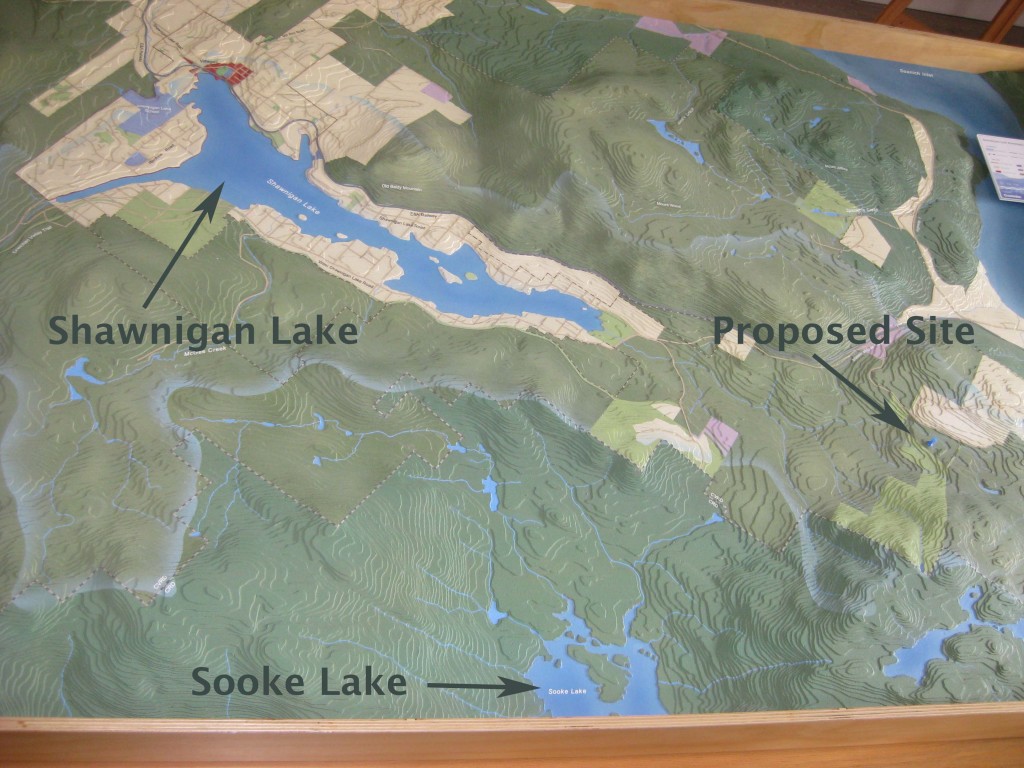 Figure 1: Photograph of a topographic map showing the locations of Shawnigan Lake, Sooke Lake and the proposed site for the contaminated soils.
Figure 1: Photograph of a topographic map showing the locations of Shawnigan Lake, Sooke Lake and the proposed site for the contaminated soils.
Five days later, the Shawnigan Residents Association (SRA) appealed the Ministry’s decision to issue SIA a permit. They cited five reasons for their appeal. The first three were:
1) The testing and assessment of the suitability of the site’s geology and hydrogeology was inadequate and incomplete.
2) The monitoring and water treatment plans were deficient.
3) The MOE failed to apply the appropriate test for the issuance of the Permit in that it failed to:
(a) ascertain the degree of scientific uncertainty about the hydrogeology, water monitoring and treatment technologies and plans;
(b) in view of the uncertainties, identify the degree of risk that the facility will not succeed in permanently containing the contaminants and toxins in the five million tons of contaminated soil to be deposited at the site.
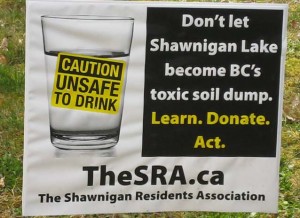 Initially, I was reluctant to wade into this issue. But as time rolled on I started to receive a number of emails and letters from concerned constituents who had vacation properties on Shawnigan Lake.
Initially, I was reluctant to wade into this issue. But as time rolled on I started to receive a number of emails and letters from concerned constituents who had vacation properties on Shawnigan Lake.
The proposed location of the contaminated soil site (Figure 1) is at an elevation above both Shawnigan Lake, the water source for about 5,000 local residents who draw directly from the lake, as well as Sooke Lake, the reservoir for Greater Victoria’s water. An additional 7,000 or so residents get their potable water from within the Shawnigan Lake watershed. Surface water runs into Shawnigan Lake while the path taken by groundwater is plagued with great uncertainty.
In its application for a stay pending a decision from the Environmental Appeal Board, Shawnigan Residents Association noted expert testimony from hydrogeologist Dennis Lowen that argued: “The site is not suitable for a landfill”. They further submitted:
“The ground on which the landfill is to be located is fractured bedrock… The site itself is an active rock quarry… The quarry has only been 4% mined, so blasting and excavating is ongoing… backfilling will be accomplished using contaminated soil instead of clean fill …the site would not, for example, be acceptable for a secure landfill under Hazardous Waste Legislation.”
On September 13, 2013, the Cowichan Valley Regional District also filed an appeal to the Environmental Appeal Board. They too took a very strong position against the proposed contaminated soils site. Amongst a variety of other concerns, they argued that:
a. There is a divergence of professional opinion and significant uncertainty in the geology and hydrogeology of the area and the associated risks to drinking water resources.
b. The characterization of the geology and hydrogeology of the area is based on a limited amount of data and a limited number of wells and boreholes not evenly distributed around the property and surrounding area.
c. The design of the proposed contaminant soil treatment facility and landfill facility does not adequately ensure that contaminated soil and ash or the associated effluent will not adversely impact drinking water resources or the environment.
Professional Reliance
In 2001 after the BC Liberals were elected to their first term, they began a comprehensive core review to cut the size of government. Premier Campbell asked all government departments to prepare scenarios as to what it would look like with 20%, 35% and 50% cuts to spending. As a direct consequence of government downsizing, technical expertise within the civil service became a casualty. Instead of having technical expertise in house, the government moved towards wide scale use of Professional Reliance in the permitting process. Under the Professional Reliance approach, the Ministry relies on the judgment and expertise of qualified experts hired by a project proponent.
What is particularly important to note is that in March 2014, the Office of the British Columbia Ombudsperson released a scathing report criticizing the Professional Reliance model with respect to streamside protection and enhancement areas. The report, entitled The Challenges of Using a Professional Reliance in Environmental Protection – British Columbia’s Riparian Areas Regulation made 25 recommendations, 24 of which the government agreed to accept. But this acceptance came almost a year after the Ministry of Environment granted SIA their permit.
My own personal view is that the government’s approach to follow the Professional Reliance model is fraught with difficulties. The role of the government is to protect the public interest. When government is making decisions solely based on a project proponent’s expert opinion, it is very troubling. Imagine a judge in a court of law only listening to the expert opinion on one side of a case (plaintiff or defendant) and not allowing expert opinion to be submitted from the opposing side.
As such, the concerns of both the CVRD and the SRA seem particularly relevant in light of the fact that they themselves brought in expert testimony that contradicted the project proponent’s evidence.
638 Stebbings Road
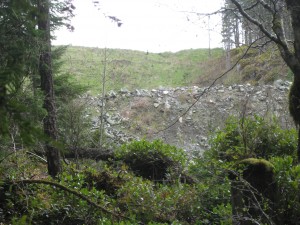 The property located at 638 Stebbings Road (known as Lot 21) is owned by 0782484 B.C. Ltd. and has been in use for quite some time as a fill site. A photograph of the northern boundary wall of deposited soils is shown to the right. This photograph was taken from CVRD Parkland on the north side of Shawnigan Creek. Lot 21 is located immediately adjacent to Lot 23. In November 8, 2013 the Environmental Appeal Board granted a stay in proceeding to the SRA and CVRD until such time as their full appeal was heard. In their decision, the Environmental Appeal Board noted a number of serious concerns regarding Lot 21. For several years, soil has been dumped Lot 21 for later use to backfill the quarry in lot 23.
The property located at 638 Stebbings Road (known as Lot 21) is owned by 0782484 B.C. Ltd. and has been in use for quite some time as a fill site. A photograph of the northern boundary wall of deposited soils is shown to the right. This photograph was taken from CVRD Parkland on the north side of Shawnigan Creek. Lot 21 is located immediately adjacent to Lot 23. In November 8, 2013 the Environmental Appeal Board granted a stay in proceeding to the SRA and CVRD until such time as their full appeal was heard. In their decision, the Environmental Appeal Board noted a number of serious concerns regarding Lot 21. For several years, soil has been dumped Lot 21 for later use to backfill the quarry in lot 23.
My site visit to the region
On the afternoon of Thursday April 2, 2015, I visited the region with Shawnigan Lake Area Director Sonia Furstenau. Together with a few other Shawnigan Lake residents, we hiked around Lots 21 and 23 on parkland owned by the CVRD. I took this opportunity to take a number of photographs. More importantly, I took the opportunity to collect water samples.
 Figure 2: Google Earth image showing the location of the SIA rock quarry and the sites where water samples were collected.
Figure 2: Google Earth image showing the location of the SIA rock quarry and the sites where water samples were collected.
The quarry located on Lot 23 (shown in Figure 2 and pictured in the banner image above) is bordered to the west by CVRD parkland and to the north by Lot 21. Our journey took us from Stebbings Road along a parkland covenant on the south side of the quarry to the parkland immediately to the west. We hiked in parkland along the western edge of the quarry and made our first stop at the northwest corner of Lot23 where the photographs below were taken. At this location there exists a pond of water (top) that drains (bottom) eventually into Shawnigan Creek.
Figure 3: Photographs taken from the northwest corner of lot 23 where there exists a pond of water (top) that eventually drains (centre) into Shawnigan Creek.
From this point we continued north along the western edge of Lot 21. Here it was readily evident that fill containing building materials was prevalent on the Lot 21 property. In fact, a significant amount of fill had over run Lot 21 and was on the neighbouring parkland. As we passed through the area I took a number of picture illustrating the type of building material that was present. A few examples are shown in Figure 4.
Figure 4: Photographs taken on CVRD land showing presence of building materials.
As evident in Figure 4, we discovered rebar, piping, concrete, asphalt, tiles, and even a tire. There seemed to be a large amount of fill in the form of building material on Lot 21.
Analysis of Water Samples
It is relatively straightforward to determine metal contents in runoff waters using an inductively coupled plasma mass spectrometry (ICPMS). Given the visible presence of steel products on the surface of the neighbouring CVRD parkland, I decided to collect water samples from two locations.
The first location (Site 1 in Figure 2 and denoted Plat in the analysis tables) was a relatively flat area that had standing water present at the surface. The second location (Site 2 in Figure 2 and donate Outflow in the analysis tables) was collected at the location where Lot 21 runoff entered Shawnigan Creek.
Figure 5: Photographs showing me collecting the water samples: Site 1 (left) and Site 2 (right).
The water flowing into Shawnigan Creek is orange (Figure 6) indicating an abundance of iron in solution.
Figure 6: Photographs of the water that runs from the north end of Site 21 into Shawnigan creek.
I passed the sample to my University of Victoria colleague Dr. Jay Cullen who in turn asked the UVic ICMPS Lab Manager, Dr. Jody Spence, if he would be able to analyse the samples. To process the samples the bottles were vigourously shaken, and the contents divided into two. One of the samples was filtered; one was not. Then 1 mL of environmental grade Nitric Acid was added to the unfiltered portion and left to sit overnight before analysis (this oxidizes and solubilizes more labile components of the precipitate that had formed). For the filtered portion, Dr. Spence used some sample to pre-rinse a clean syringe (all plastic, no rubber), and then filtered about 25 mL of sample through a 0.45 micron disposable filter. To this he added 0.5 mL of Nitric acid and let it sit overnight as well.
The results of the analysis are available in pdf format. All units in this table are in μg/L (micro gram per litre).
Schedule 6 of the Contaminated Sites Regulation of the Environmental Management Act lays out water standards for aquatic life, irrigation, livestock and drinking water. I will only concentrate on the drinking water standard although others may wish to compare my water results for aquatic life standards. As noted in Schedule 6 “Drinking water standards are for unfiltered samples obtained at the point of consumption.”
What is readily apparent from the analysed data is that the iron (Fe) levels fail drinking water standards locally. Manganese (Mn) levels are also high. These levels are almost certainly associated with the presence of buried steel (rebar, building materials etc.) on Lot 21. Nevertheless, by the time the water gets into Shawnigan Lake it will be so diluted that it would no longer fail these standards.
What is also important to note is that I have yet to analyse the water for hydrocarbon content. The presence of asphalt throughout the fill area would suggest that one might indeed expect to find hydrocarbons in the outflow.
Summary
What is apparent to me is that there are substantial amounts of building materials that have been placed on Lot 21. There is clear evidence that runoff from this site fails drinking water standards at the point of entry with Shawnigan Creek. And visually, this water looks nothing like any other water in nearby surface and running water. Missing from my analysis is an examination of hydrocarbon contents in the waters. I’ll save that for a later date.
There is conflicting evidence between the expert opinion provided as part of SIA’s application for a permit and that obtained by Shawnigan Resident’s Association. Herein lies the critical problem with the entire permitting process. The Professional Reliance model for project permitting in use in British Columbia is inherently flawed. No matter what project is seeking approval, when the government bases its decision on the professional advice provided by a project proponent, there will always be public concern. In fact basing approval decisions on the Professional Reliance Model makes it difficult, if not impossible, for a project to earn a social license to proceed.
The role of government is to protect the public interest while at the same time giving industry certainty with respect to the project approval process. My own view is that in order for both public and industry interests to be served transparently and fairly, British Columbia should move away from the Professional Reliance Model and instead create arms length and independent expert oversight panel(s). This can be accomplished by expanding in-house government technical expertise and using that expertise to set up independent oversight of a proponent’s project plan, paid for by the proponent. In addition, the Office of the British Columbia Ombudsperson report mentioned above and entitled The Challenges of Using a Professional Reliance in Environmental Protection – British Columbia’s Riparian Areas Regulation outlined a number of ways of improving the Professional Reliance model.
So how do we move forward from here? It makes little sense to me to dump contaminated soils in the Shawnigan Lake watershed. In addition, there are sufficient uncertainties in ground water processes/flow in the region that I don’t believe it is wise to place the contaminated soils at an elevation higher than nearby Sooke Lake (the source of Victoria’s drinking water). While overall risk may be small, it certainly is not zero and so it would be prudent to apply the precautionary principle in light of the stakes involved.
Instead, perhaps one of the three existing sites owned and operated by Tervita on Vancouver Island could take the contaminated soils. One is in the Highlands, one is in Cumberland and one is near Port McNeill. Tervita has a long history of successfully operating contaminated soil sites. If additional capacity is needed, then let’s start the process over again and search for a different location. But this time either follow the advice of the Ombudsperson’s office or establish and independent panel to oversee the permitting process.
Postscript
I discussed this issue further on CBC radio with Gregor Craigie on Earth Day (April 22, 2015).
We’ve Got Lots to Learn from Vancouver’s Oil Spill
Since last weeks’ oil spill in English Bay, British Columbians living in the lower mainland and across the province have felt let down by their governments.
Despite big promises about ‘world class’ spill response, what we witnessed in English Bay proves beyond a doubt that the term ‘world class’ amounts to little more than a soundbite.
You could, however, forgive British Columbians for feeling let down for another reason. They have been watching as their politicians fall over themselves to point fingers and lay blame at their opponents’ feet.
Concerns about oil spills have been growing in B.C. ever since Enbridge’s Northern Gateway pipeline was first put forward. With Kinder Morgan’s proposed Trans Mountain pipeline routed to come straight to Vancouver harbor, those concerns have come even closer to home.
Many people are now seeing first hand how unprepared we are for a spill.
However, our lack of response capacity doesn’t come as a surprise to anyone who has been paying attention to the Kinder Morgan hearing process.
As I write this, we are in the midst of a seriously flawed National Energy Board hearing process on Kinder Morgan’s Trans Mountain pipeline. If approved, the number of oil tankers leaving Vancouver harbor would increase by 580%.
In contrast to the 2700 litres that spilled, each of these tankers would carry up to 110,000 tonnes of oil along our coastline. Unlike the bunker fuel that spilt in English Bay, which largely floats, the diluted bitumen that these tankers would carry can sink. If that happens, we currently have no way of cleaning it up.
To date, Kinder Morgan – through the hearing process – has refused to consider even the possibility of a spill larger than 15% of what a single tanker would carry. When they did simulate a spill, they applied unrealistic conditions assuming, for instance, that wave and wind conditions would be minimal and that there would be 20 hours of sunlight in August for clean-up crews. (For the record: You would have to go to Tuktayotuk on the Arctic coastline to find 20 hours of sunlight in August!).
Roughly one third of the nearly 600 questions I submitted were not adequately answered. And I’m not alone.
The Cities of Burnaby and Vancouver have been true leaders in the hearings. Together they have submitted thousands of questions to Trans Mountain and countless motions as they advocate for a better process. They too have struggled to get answers to even basic questions.
Sadly, that same leadership has been largely absent on the provincial scene.
In a process that affects all British Columbians, not a single B.C. NDP or B.C. Liberal MLA even applied to be an intervenor.
This hearing is the best opportunity MLAs have to evaluate our spill response capacity in the context of the proposed increase in oil tankers. It allows us to explore how prepared we are for a spill, and what steps are being planned to address the significant gaps.
My staff and I have poured hundreds of hours into this process, studying Trans Mountain’s application and submitting countless questions.
That is why the finger pointing is so frustrating. It is politicking with a disaster when you have played little role in actually addressing the concerns ahead of time.
The clear absence of provincial leadership in these hearings has allowed us to get to where we are today. Had more MLAs been more vocal, we may have a more rigorous hearing process.
Yet it’s not too late. I have been calling for the B.C. government to pull out of the NEB hearings and hold their own review process for some time now. The B.C. NDP and countless British Columbians have done the same. All that stands in the way is government leadership.
I hope that the spill in English Bay will spark more than just finger pointing. I hope it will serve as a wake-up call that British Columbians need to expect more from their MLAs.
They should expect us to do what’s necessary to prevent a spill from occurring in the first place – not to line up after the fact to assign blame.
The Pacific Coast Herring Fishery
The long-standing Fisheries and Oceans Canada (DFO) policy to allow a Sac-Roe Fishery (SRF) harvest of herring eggs has always been incredibly wasteful and shortsighted. It is an industry that has triggered a cascading decline of economic, cultural and ecological well-being in B.C. The intensive reduction fishery started in the early 1930s and continued until all five major stocks collapsed in the late 1960s. Pacific herring populations recovered rapidly following a four year fishery closure but the species is prone to collapse and abundance has declined again recently, with little evidence of recovery. Using seine or purse nets to capture schools of pre-spawn herring, SRF boats can kill thousands of tonnes of fish in a matter of minutes. Of those huge catches, only the roe is removed for human consumption; the carcasses are treated as by-product and used to make feed tablets for fish farms, bait or put into garden fertilizers. As herring can spawn seven or eight times over their lifetime, this kill-fishery not only removes huge biomass from the overall herring population, but destroys their ability to reproduce in future years.
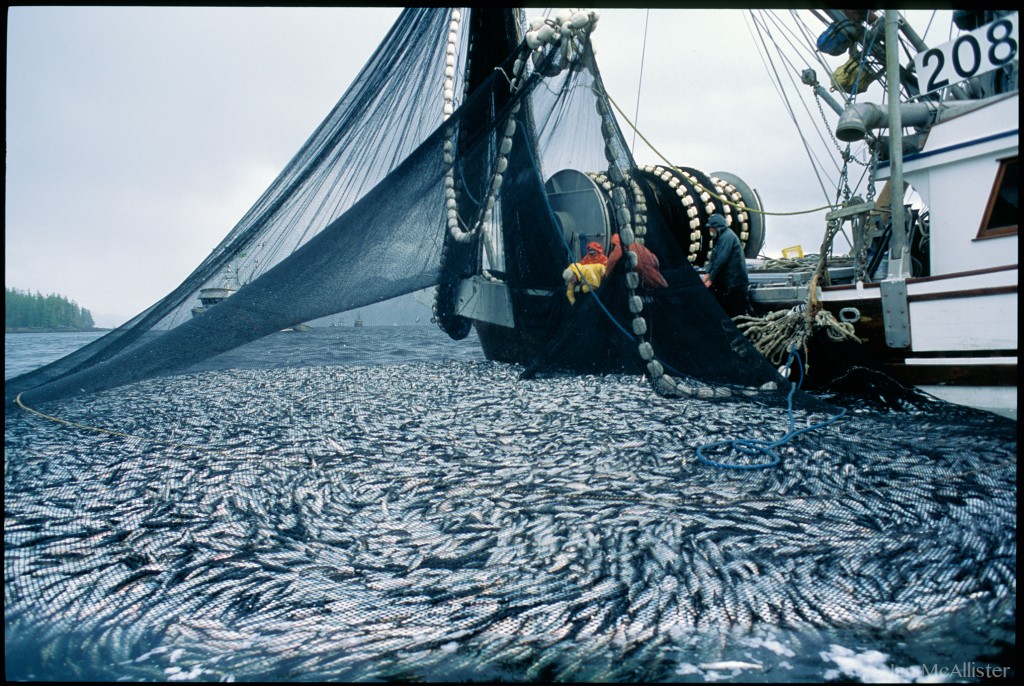 Herring captured in seine nets March 2015, photo by Ian McAllister
Herring captured in seine nets March 2015, photo by Ian McAllister
This fishery is systematically extirpating one of B.C.’s most important foundational and keystone species. Granted, there are many other wasteful industries in our country, but what makes this one so spectacularly so is the fact that there is a clear, effective, and sustainable alternative. It is not a new method of harvesting herring eggs, quite the opposite, it has been used along the B.C. coast for thousands of years. Herring bones that have been uncovered deep in the substrate of ancient village sites provides evidence of the long relationship between the first peoples of this coast and herring.
The Heiltsuk people today, like the countless generations before them, travel to the traditional herring spawning grounds in anticipation of the inshore herring migration. Heiltsuk families anchor logs and other flotation devices to the seabed and attach lines of hemlock branches or seaweed to them – essentially mimicking ideal herring spawn habitat. With luck, herring will see these branches and kelp fronds and choose them as a spawning location, after a few days multiple layers of eggs will coat the vegetation and the harvest can begin.
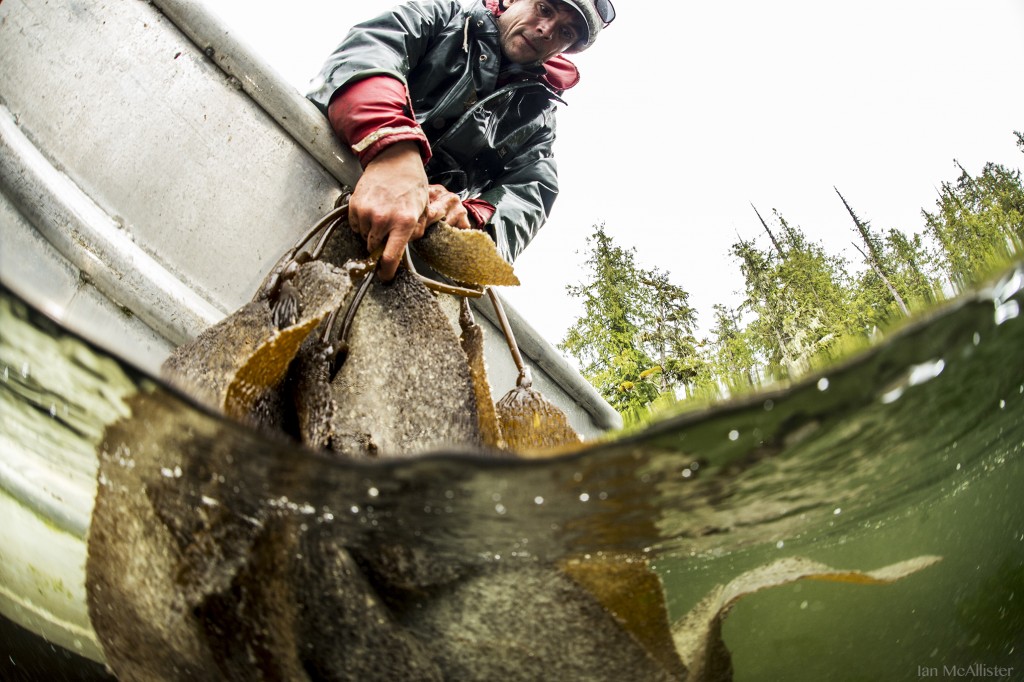 Spawn-on-kelp herring roe harvest. Kelp covered in eggs are pulled from the water on the central B.C. coast, photo by Ian McAllister
Spawn-on-kelp herring roe harvest. Kelp covered in eggs are pulled from the water on the central B.C. coast, photo by Ian McAllister
The Heiltsuk choose hemlock branches because of the needles’ flavour and medicinal benefits, but also because the natural resins provide a lot of sticky surface area for the eggs to attach themselves. Certain species of kelp are preferred over hemlock by some families, and spawn on kelp remains the main product used for export.
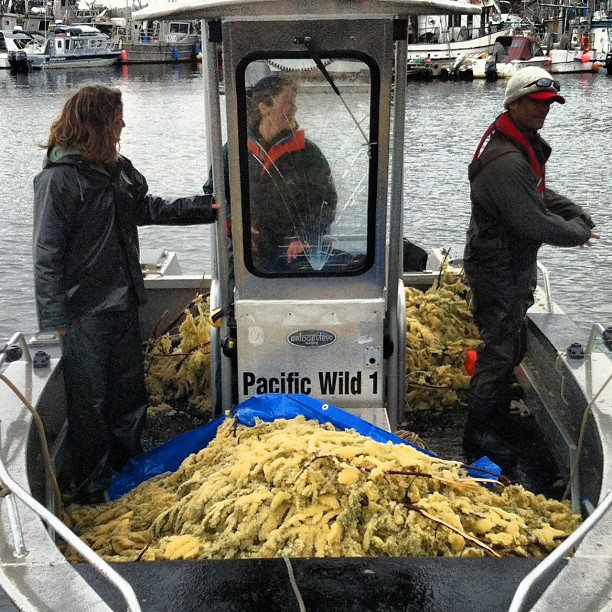 Hemlock branches coated with herring eggs, harvested near Bella Bella, B.C. Photo by Max Bakken
Hemlock branches coated with herring eggs, harvested near Bella Bella, B.C. Photo by Max Bakken
These days, as the world’s oceans are picked clean for human consumption, the words ‘sustainable fishery’ have lost their meaning. In contrast, this traditional fishery has a very small footprint. It also maximizes ecological and economic benefits as the herring get to live and continue to spawn for successive generations.
Compare this to the DFO industrial-scale kill fishery model and it becomes shameful that the Heiltsuk and other Nations have not been more supported for the long battle that they have been waging against DFO, both in the courts and by active blockades on the herring grounds – to shut this unsustainable fishery down. Like the east-coast cod and so many other fisheries that have collapsed at the hands of DFO, herring stocks here are following the same path and hundreds of traditional spawning areas in the territory have gone silent.
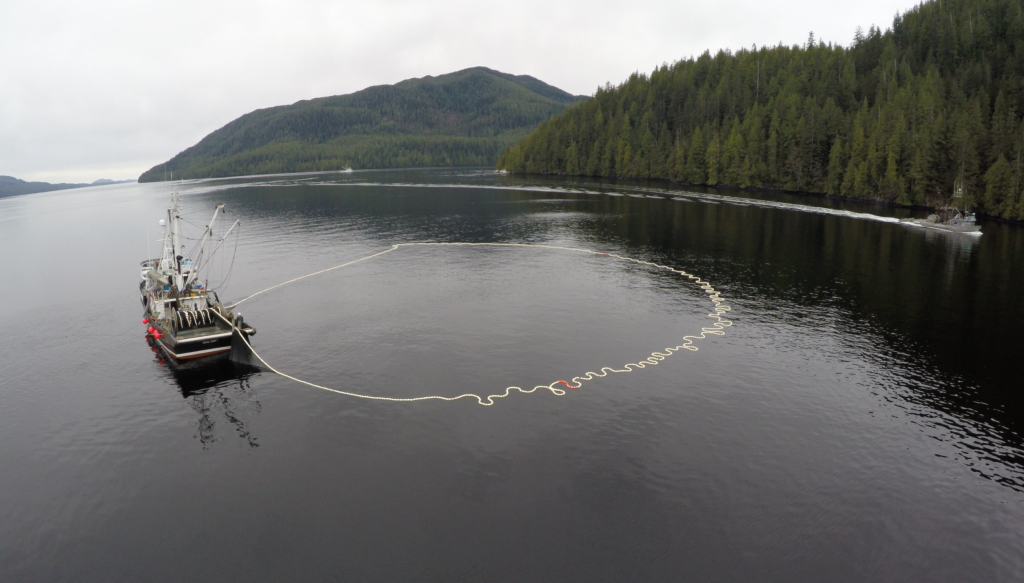 Seine nets set to harvest herring on the B.C. central coast, photo by Ian McAllister
Seine nets set to harvest herring on the B.C. central coast, photo by Ian McAllister
When the Heiltsuk fishers go out on the grounds they are bringing with them generations of experience and knowledge. The logic behind the SRF industry, however, hits a dead-end pretty quickly. One does not have to use much foresight to see that a fishery founded on the mass and unnecessary killing of future spawning populations is doomed to harvest itself into the ground. All of the hallmarks of hunter-overkill are evident with the herring fishery. More corporate control of the fishery, more technology being used with bigger boats and hi-tech sonars while the fish get smaller in size forcing more immature fish to be harvested. This not only destroys the fish with greatest lifetime spawning potential, it is not even profitable as immature fish (2-3 years old) have fragile stomach linings that burst before any roe can be harvested.
The DFO releases an annual ‘Pacific Herring Integrated Fisheries Management Plan’, which, on the surface, appears to be a comprehensive report. Reading ten years worth of these documents, however, only further convinced me that the DFO not only has a limited understanding of herring’s ecological importance, requirements, or how to safely manage them, they also don’t seem to care. Take this section of the 2004 report, for example: “At this time there is no information available on the appropriate conservation limits for the ecosystem as it pertains to the herring stocks”. It continues on to talk about harvest rates, and ends with: “Research is ongoing to better understand these ecosystem processes and the role herring plays in maintaining the integrity and functioning of the ecosystem.” This paragraph, on page two, appears sincere enough, a commitment to future herring research is definitely important. I then read the exact, word for word, statement in the 2013 report. Nine years later they have failed to do any of the conservation research they claimed to be working on, and they don’t even care enough to write a new excuse.
In 1996 conflicts between First Nations’ fishing practices and DFO’s regulations reached the Supreme Court of Canada when two Heiltsuk brothers, William and Donald Gladstone, were arrested for selling SOK. In what has become known as the Gladstone Commission, the Heiltsuk Nation argued their case and became the first Nation in Canada to be granted a court-affirmed, un-extinguished aboriginal right to commercially harvest and sell SOK. Unfortunately, this victory was not the end of the Heiltsuk Nation’s struggle with DFO. The SRF continued to kill thousands of tonnes of herring biomass every year resulting in extirpation of stocks throughout the territory.
In March, the Heiltsuk declared a tribal ban on commercial sac roe fishing in all of Area 7, including Spiller Channel, to preserve the region’s threatened herring stock. DFO opened the herring sac roe seine fishery in Spiller Channel shortly after.
“This action shows blatant disrespect of aboriginal rights by DFO and industry,” Chief Councillor Marilyn Slett told the CBC.
“DFO provided inconsistent and misleading communications throughout the day and did not attempt meaningful consultation,” said Slett.
“We must put conservation first. We have voluntarily suspended our community-owned commercial gillnet herring licenses for this season to allow stocks to rebuild, but DFO and industry are unwilling to follow suit,” said Kelly Brown, director of the Heiltsuk Integrated Resource Management Department.
In response to the situation, Fisheries and Oceans Canada told the CBC “We were committed to providing harvest opportunities where they were possible. A purse seine fishery did occur on March 22nd, yielding 690 tons of an available 800 tons. This fishery is now closed.”
The historical and ongoing treatment of herring by DFO is a tragedy. The constant theme underlying years of collapses and management failures is a complete disregard for the essential role these forage fish play in B.C.’s ecosystem and First Nations culture. Whales, dolphins, seals, sea lions, cod, salmon and sea birds all feed heavily on herring, making those small fish hugely important in the coastal ecosystem. This miraculous, mysterious species – which provides a foundation for so many – needs more support.
Banner Image: Shoreline waters change colour as the herring spawn begins in the Great Bear Rainforest, photo by Ian McAllister
Aerial Culling of Wolves to Save Endangered Caribou – The Rationale
In mid January, after receiving numerous emails from British Columbians across the province, I wrote to the Minister of Forests, Lands and Natural Resource Operations to ask a number of questions concerning the rationale for the wolf cull in the South Selkirk Mountains and the South Peace of British Columbia. I have now received a very detailed, comprehensive and thoughtful response to the questions that I posed. I encourage you to read the Minister’s response.
As noted in the response, the situation in the South Selkirk has changed since Steve Wilson wrote his 2010 report entitled “Estimating the Short-term Benefit of Wolf Management to Mountain Caribou Herds”. The Selkirk caribou population dropped from 46 to 18 caribou from 2009 to 2014 after increasing from 2004 to 2009. Few wolves were in the area during the earlier period while increasing numbers have been present in recent years and “the most recent confirmed mortalities on the South Selkirk herd are due to wolf predation”.
The Minister’s letter also outlines steps that have been or are being taken to preserve the caribou’s natural habitat. In addition, it outlines several predator management projects that are being developed on a trial basis.
The Minister also provided me with both a report plan and a peer review of the report plan. A key finding of the report was:
“The South Selkirk caribou population is declining by 30% to 40% per year (as demonstrated by the population numbers listed in the operational plan. Based on this rate of decline, the caribou population will likely be in a state of quasi-extirpation within a year.”
It’s clear from the evidence that the South Selkirk caribou population is near extinction and that predation by wolves is a leading cause of most recent mortalities. As a society, I believe we have a responsibility to protect endangered species. It is clear that a choice needs to be made. Not dealing with the growing wolf population would mean almost certain extinction of the caribou herd. Dealing with the growing wolf population gives this herd a fighting chance.
Not withstanding this short-term emergency measure that needs to take place, and the government’s recent efforts to create and preserve increased habitat for the caribou, I will continue to monitor government’s 2008 “Interim Strategy for Predator/Prey Management Actions in Support of Mountain Caribou Recovery”, where it notes that “habitat loss and fragmentation is largely the ultimate cause of mountain caribou declines”.

